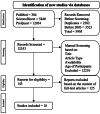Pain Management During Adult Laparoscopic Appendectomy: A Systematic Review
- PMID: 38344561
- PMCID: PMC10853664
- DOI: 10.7759/cureus.52037
Pain Management During Adult Laparoscopic Appendectomy: A Systematic Review
Abstract
The opioid epidemic has become a critical public health issue, driven by the widespread distribution and misuse of prescription opioids. This paper investigates analgesic management in the context of laparoscopic appendectomy (LA) as an alternative to open appendectomy, aiming to reduce the reliance on opioids for postoperative pain control. A comprehensive literature review was conducted from January 1, 2003, to November 1, 2023, utilizing PubMed, ProQuest, and ScienceDirect databases. The search focused on peer-reviewed experimental and observational studies involving adults (18 years and older) undergoing LA. The original search resulted in 18,258 publications, which were then screened using PRISMA guidelines. Among the filtered 18 studies included for analysis and review, the transition from open to LA demonstrated a consistent decrease in postoperative pain, leading to a reduced need for opioid prescriptions. Analgesic strategies included the use of local anesthetics (lidocaine, bupivacaine, ropivacaine), spinal/epidural anesthesia, nerve blocks, and a multimodal approach with NSAIDs and acetaminophen. Studies demonstrated the efficacy of local anesthetics in reducing postoperative pain, prompting a shift toward non-opioid analgesics. The use of spinal/epidural anesthesia and nerve blocks further supported the trend of minimizing opioid prescriptions. While some variations in anesthetic approaches existed, overall, patients undergoing LA required fewer opioid doses, reflecting a positive shift in postoperative pain management. Patients undergoing LA experienced lower rates of readmission, reduced post-operative pain, better cosmetic outcomes, and shorter recovery times, contributing to a diminished demand for opioid medications. This review underscores the potential for non-opioid analgesic strategies in surgical contexts, aligning with the broader imperative to address the opioid epidemic and promote safer and more sustainable pain management practices.
Keywords: anesthesia; appendicitis; laparoscopic appendectomy; opioids; pain management.
Copyright © 2024, Biput et al.
Conflict of interest statement
The authors have declared that no competing interests exist.
Figures
Similar articles
-
Pain Management Throughout Pediatric Laparoscopic Appendectomy: A Systematic Review.Cureus. 2023 Nov 28;15(11):e49581. doi: 10.7759/cureus.49581. eCollection 2023 Nov. Cureus. 2023. PMID: 38156159 Free PMC article. Review.
-
Effectiveness of ondansetron as an adjunct to lidocaine intravenous regional anesthesia on tourniquet pain and postoperative pain in patients undergoing elective hand surgery: a systematic review protocol.JBI Database System Rev Implement Rep. 2015 Jan;13(1):27-38. doi: 10.11124/jbisrir-2015-1768. JBI Database System Rev Implement Rep. 2015. PMID: 26447005
-
A retrospective study of multimodal analgesic treatment after laparoscopic appendectomy in children.Paediatr Anaesth. 2013 Dec;23(12):1187-92. doi: 10.1111/pan.12271. Epub 2013 Sep 25. Paediatr Anaesth. 2013. PMID: 24112856
-
Reduced Opioid Prescription Practices and Duration of Stay after TAP Block for Laparoscopic Appendectomy.J Gastrointest Surg. 2020 Feb;24(2):418-425. doi: 10.1007/s11605-018-04100-0. Epub 2019 Jan 22. J Gastrointest Surg. 2020. PMID: 30671804
-
Evolving Role of Local Anesthetics in Managing Postsurgical Analgesia.Clin Ther. 2015 Jun 1;37(6):1354-71. doi: 10.1016/j.clinthera.2015.03.017. Epub 2015 Apr 10. Clin Ther. 2015. PMID: 25866297 Review.
References
-
- The opioid epidemic: crisis and solutions. Skolnick P. Annu Rev Pharmacol Toxicol. 2018;58:143–159. - PubMed
-
- Acute appendicitis: efficient diagnosis and management. Snyder MJ, Guthrie M, Cagle S. https://www.aafp.org/pubs/afp/issues/2018/0701/p25.html?utm_medium=email.... Am Fam Physician. 2018;98:25–33. - PubMed
Publication types
LinkOut - more resources
Full Text Sources

